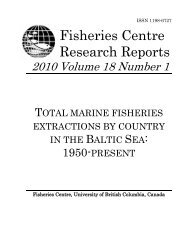reconstruction of sri lanka‟s fisheries catches - Sea Around Us Project
reconstruction of sri lanka‟s fisheries catches - Sea Around Us Project
reconstruction of sri lanka‟s fisheries catches - Sea Around Us Project
Create successful ePaper yourself
Turn your PDF publications into a flip-book with our unique Google optimized e-Paper software.
Commercial <strong>fisheries</strong><br />
Total commercial landings for Sri<br />
Lanka were available in nationally<br />
published reports as well as by the<br />
FAO; however, the national data<br />
contained a statistical error causing<br />
landings to be high for years prior to<br />
1970 (Pathirana, 1972); landings<br />
reported to FAO and obtained from<br />
FAO FishStat were lower than<br />
nationally reported landings prior to<br />
1970 (Figure 3). Therefore, it was<br />
assumed that the statistical error in<br />
the national data was accounted for<br />
and corrected in landings presented<br />
in FAO‟s FishStat. Landings<br />
presented by the FAO were also more<br />
complete from 1980-1990, where<br />
national landings data were sparse.<br />
FAO data for crustaceans were<br />
compared to prawn and lobster landings presented by NARA. For the 1994-2002 time period, prawn and<br />
lobster landings were used in place <strong>of</strong> the FAO‟s „miscellaneous marine crustaceans‟ grouping, as they were<br />
deemed to be a better representation <strong>of</strong> total crustacean <strong>catches</strong> (Figure 5). Marine crab <strong>fisheries</strong>, although<br />
known to occur in Sri Lanka, were assumed to be contained within a new, but smaller miscellaneous<br />
crustaceans category as no data was available to determine catch. With the exception <strong>of</strong> the amendment to<br />
crustaceans landings, the remainder <strong>of</strong> the FAO data was considered a good representation <strong>of</strong> commercial<br />
<strong>fisheries</strong> landings, both for the artisanal and industrial sectors. These landings were used as a baseline, to<br />
which we added components not accounted for in the <strong>of</strong>ficially reported data. Noteworthy are two nonfishery<br />
related events which are correlated with a noticeable decrease in landings over the time period<br />
considered; the beginning <strong>of</strong> the civil war in 1983 and the tsunami which occurred on December 26 th,<br />
2004.<br />
Discards<br />
Shrimp trawl <strong>fisheries</strong> are typically associated with considerable bycatch, which can either be landed or<br />
discarded at sea. A study in the late 1970s estimated bycatch associated with the shrimp fishery in two <strong>of</strong><br />
Sri Lanka‟s main shrimp trawling grounds, Jaffna and Mannar (Subasinghe, 1981). The study provided<br />
estimates for both the landed and discarded components <strong>of</strong> the bycatch. Subasinghe (1981) presents<br />
discard rates for both areas, which gave an average rate <strong>of</strong> 10.2 kg <strong>of</strong> discards per kg <strong>of</strong> shrimp landed for<br />
1979 (Discard rates for Mannar and Jaffina were 8.92 and 11.48 kg discarded per kg landed, respectively).<br />
These two regions were responsible for 60% <strong>of</strong> the commercial production <strong>of</strong> shrimp that year<br />
(Subasinghe, 1981; Saila, 1983). Therefore, we assumed that this discard rate was representative <strong>of</strong> Sri<br />
Lanka‟s shrimp trawl <strong>fisheries</strong> and applied the rate <strong>of</strong> 10.2 kg discards per<br />
kg <strong>of</strong> shrimp landed across the entire time period. Discards may have<br />
been even higher in earlier time periods due to greater benthic biomass<br />
and/or less storage capacity on vessels for non-target species; however, to<br />
remain conservative we held the discard rate constant back in time to<br />
1950. For the recent time period, we carried the 1979 discard rate<br />
forward, unaltered, to 2008. This same study reported that over 80% <strong>of</strong><br />
the discarded catch was silverbellies (Leiognathidae); we considered the<br />
remainder to be miscellaneous small pelagic fishes and miscellaneous<br />
sharks.<br />
Depending on the type <strong>of</strong> gear used, bycatch is also <strong>of</strong> concern for tuna<br />
<strong>fisheries</strong>. The majority <strong>of</strong> tuna <strong>catches</strong> in Sri Lanka are skipjack tuna<br />
(Katsuwonus pelamis), representing roughly 60% <strong>of</strong> tuna <strong>catches</strong> and<br />
Catch (t x 10 4 )<br />
14<br />
12<br />
10<br />
8<br />
6<br />
4<br />
2<br />
0<br />
National<br />
1950 1960 1970<br />
Year<br />
Figure 3: Comparison <strong>of</strong> landings data as presented by FAO<br />
and the national data source, indicating the statistical error in<br />
the national data, and its correction in data presented by FAO<br />
on behalf <strong>of</strong> Sri Lanka.<br />
Table 1. Estimated seafood<br />
consumption rates derived from<br />
the Department <strong>of</strong> Census and<br />
Statistics 2007 Household<br />
Income and Expenditure<br />
Survey.<br />
Year Per capita demand<br />
(kg∙person -1 ∙year -1 )<br />
1981 19.39<br />
1986 18.24<br />
1991 14.64<br />
2002 19.86<br />
2005 24.12<br />
2007 24.12<br />
yellowfin tuna (Thunnus albacares), representing approximately 20% <strong>of</strong> the tuna <strong>catches</strong>. Tuna are<br />
predominantly caught using gillnets, although, longlines are becoming increasingly popular for <strong>catches</strong><br />
FAO





![Nacion.com, San José, Costa Rica [Nacionales] - Sea Around Us ...](https://img.yumpu.com/26166123/1/190x245/nacioncom-san-josac-costa-rica-nacionales-sea-around-us-.jpg?quality=85)










